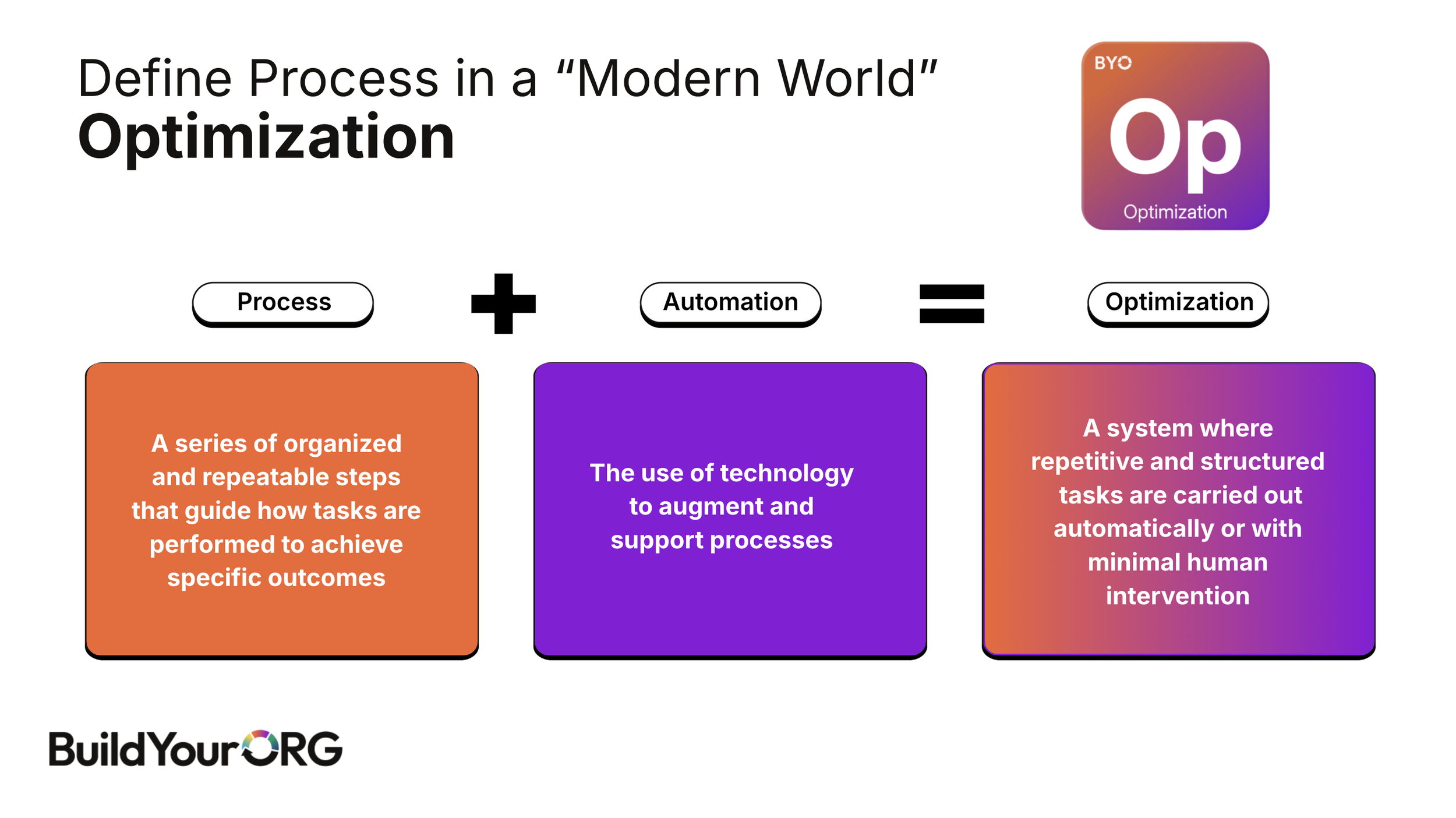🚀 The Power of Process Optimization in the Modern Business Landscape
In today's fast-paced business environment, organizations are constantly seeking ways to improve efficiency, reduce costs, and enhance productivity. One of the most effective strategies for achieving these goals is through process optimization. But what exactly does this mean in our modern, technology-driven world? Let's dive deep into the concept of process optimization and explore how it's reshaping the way businesses operate.
1. 🧮 Understanding the Components: Process + Automation = Optimization
At BuildYourOrg, we've distilled the essence of modern process optimization into a simple yet powerful equation:
Process + Automation = Optimization
This formula encapsulates the key elements required to achieve true efficiency in today's business landscape. Let's break down each component:
a) 🔄 Process: The Foundation of Efficiency
Process is defined as "a series of organized and repeatable steps that guide how tasks are performed to achieve specific outcomes." In other words, it's the systematic approach to getting things done. Well-designed processes are the backbone of any efficient organization, providing structure, consistency, and clarity in operations.
Key benefits of strong processes include:
Reduced errors and improved quality
Increased productivity
Better resource allocation
Enhanced scalability
Improved compliance and risk management
b) 🤖 Automation: The Catalyst for Speed and Accuracy
Automation is "the use of technology to augment and support processes." In the modern business world, automation tools and technologies play a crucial role in streamlining operations and reducing manual effort. From simple task automation to complex AI-driven systems, automation is revolutionizing how work gets done.
Advantages of implementing automation include:
Increased speed and efficiency
Reduced human error
Cost savings
Improved data accuracy and consistency
Enhanced customer experience
c) 🏆 Optimization: The Ultimate Goal
When process and automation are combined effectively, we achieve optimization. This is defined as "a system where repetitive and structured tasks are carried out automatically or with minimal human intervention." Optimization represents the pinnacle of efficiency, where processes are not just well-designed and automated, but continuously refined for maximum performance.
Benefits of true optimization include:
Maximized resource utilization
Rapid adaptability to changing conditions
Data-driven decision making
Competitive advantage
Increased innovation capacity
2. 🛤️ The Journey to Process Optimization
Achieving process optimization is not a one-time event but a continuous journey. Here are some key steps organizations can take to move towards optimal efficiency:
a) Analyze Current Processes Begin by mapping out existing processes and identifying bottlenecks, redundancies, and areas for improvement.
b) Standardize and Document Create clear, standardized documentation for all key processes to ensure consistency and facilitate training.
c) Identify Automation Opportunities Look for repetitive, rule-based tasks that can be automated using available technologies.
d) Implement and Integrate Carefully implement automation tools and integrate them with existing systems and processes.
e) Monitor and Measure Use analytics and performance metrics to track the impact of process changes and automation implementation.
f) Continuously Improve Foster a culture of continuous improvement, encouraging feedback and ideas from all levels of the organization.
3. 🚧 Challenges and Considerations
While the benefits of process optimization are clear, it's important to be aware of potential challenges:
Resistance to change from employees
Initial costs of implementing new technologies
Need for ongoing training and skill development
Balancing automation with the human touch in customer-facing processes
Ensuring data security and compliance in automated systems
4. 🔮 The Future of Process Optimization
As technology continues to evolve, so too will the possibilities for process optimization. Emerging trends to watch include:
AI and machine learning for predictive process optimization
Robotic Process Automation (RPA) for more complex task automation
Low-code/no-code platforms for easier automation implementation
Internet of Things (IoT) for real-time process monitoring and optimization
Blockchain for secure, transparent process management
🎯 Conclusion
In the modern business world, process optimization through the combination of well-designed processes and intelligent automation is no longer a luxury—it's a necessity. Organizations that embrace this approach will be better positioned to adapt, compete, and thrive in an increasingly complex and fast-paced environment.
By understanding the equation of Process + Automation = Optimization, businesses can unlock new levels of efficiency, productivity, and innovation, setting the stage for sustainable success in the digital age.
Remember, the journey to optimization is ongoing. Start small, learn continuously, and don't be afraid to reimagine how work gets done. The future belongs to those who can optimize their processes for the challenges and opportunities of tomorrow. 🚀💡🌟

